SANS (fr.) / SIN (sp.) SOIL
/4 Comments/in Gardening/by Lee ReichClarabel And Abbe Fetel
The UPS guy delivered two large, long boxes last week. Laid out in each box as in a coffin was what looked like a sturdy, 4-foot long stick. You wouldn’t think that either stick, one labelled Clarabel quince and the other labelled Abbe Fetal pear, could ever become a tree, could ever even come to life! Unpacking, then holding one of the sticks up, its bare roots dangling in the air, I had my doubts about the plant’s viability, even though I’ve planted many bare root trees over many years.
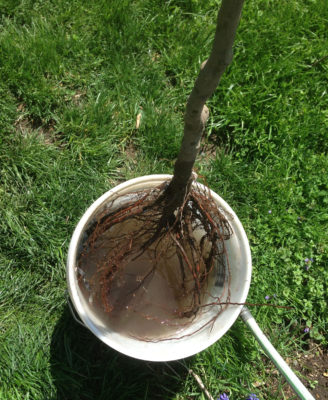
Bare root tree soaking
Bare root trees are grown at a nursery and, sometime between fall and spring while still leafless and dormant, are dug up, their roots shaken free of soil, and shipped. Before shipping a tree, a good nursery will tuck moist sphagnum moss, shredded newspaper, or other water retaining material in among the roots, then swaddle the roots and moist packaging all in plastic.
Some loss of large roots is unavoidable when digging a bare root tree. Less obvious is loss of tender root hairs. And roots don’t ever like being out of the soil. So why didn’t I just order a potted tree, which hardly need know that it’s been moved, rather than a bare root tree?
The main reason for buying a bare root Claribel quince or Abbe Fetel is because there’s not much chance of finding a potted one locally or, probably, anywhere. Bare root trees and shrubs are cheaper to buy and cheaper to mail than potted trees and shrubs, and are available in much greater variety.
Treated well, growth of bare root trees and shrubs will match that of their potted counterparts. Good treatment doesn’t end at the nursery. Soon after unpacking Claribel and Abbe Fetel, their roots were in a bucket of water, to soak for a few hours. Planting holes were dug just deep enough to set each tree at the same depth as at the nursery (as evidenced by the soil line on the trunk) and twice as wide as the spread of the roots. Abbe Fetal had a couple of straggly roots; I clipped them back to the same length as the other roots.
Holding a tree in place with one hand, I sifted soil back in among the spread roots in the planting hole, working the soil in amongst roots by poking with my fingers and occasionally bouncing the plant up and down slightly. After planting, a thorough watering further settled soil in amongst the roots. An icing of mulch — I used wood chips — and the plant, still looking like nothing more than a stick, was ready to go, as far as I was concerned.
Daphne . . . Alive
Last year I bought a potted Daphne bush at a local garden center. As I tipped the plant out of the pot to nestle into its waiting planting hole, all the potting soil fell away from the roots.
It’s not uncommon for a garden center to buy in bare root trees and shrubs, just as I did with Clarabel and Abbe Fetal, then pot them up for sale. Roots in some soil are ready to take in nutrients and water as soon as when warm weather coaxes out new leaves and shoots. Some weeks must pass before the roots actually grow out into the potting soil, though.
The Daphne was leafed out but hardly rooted when I tipped it out of the pot, making it again bare root. I had doubts about its survival. But it did survive. Still, it was an expensive bare-root plant.
Annuals In Cells
A hundred or so years ago, even tender, annual vegetable transplants were re-located to their new homes bare root. Tomatoes would be grown in cold-frames, hot beds, or greenhouses, then gingerly lifted free of the soil. Kept out of the sun and with their roots moist in a bucket of water, the plants were moved to the field or garden and planted, preferably on an overcast day. If the day was dry and sunny, a cedar shingle might be shoved into the ground to shade the plant for a day or two.
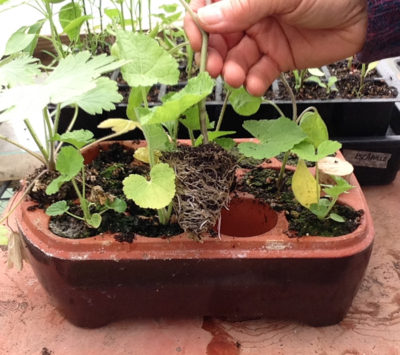
Transplant in Orto pot
These days, as you know, vegetable transplants come in plastic cell packs, each plant in its own mini-pot. For tender, small annual plants, potted is much better than bare-root.
Clarabel Has Risen
Resurrection! Only a few days after planting Clarabel and Abbe Fetel, and, like magic, green buds have swollen along the once dead-looking stems.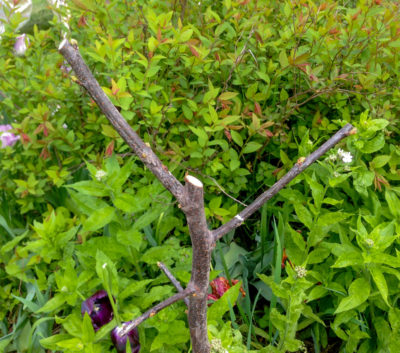
DESIGNS ON GARDENING
/11 Comments/in Design, Gardening, Tools, Vegetables/by Lee ReichThe Turn Of The Year
Sure there’s seed-sowing, weeding, and pruning to do, but I’ve also been spending a good amount of time communing with my pitchfork. Turning compost.
Some people are put off by the thought of having to turn compost. Don’t be. Compost does not have to be turned. Any pile of organic materials will eventually become compost.
Still, I like to turn my composts. I typically build new piles (a lot of them!!) through summer into fall, turn them the following spring, and then spread the finished compost that fall or the following spring. As I fork the ingredients from the old pile into the adjacent bin, I break up any clumps with the pitchfork and fluff up any parts that seem sodden and gasping for air. A nearby hose makes it convenient to spray any dry areas.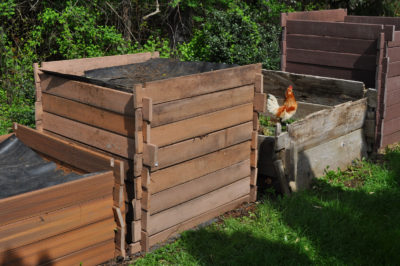
Everything organic (was once or is living) — hay, weeds, old plants, some horse manure, old cotton clothes, vegetable trimmings — goes into my compost, and that includes, unavoidably, weed seeds. Turning my compost pile exposes weed seeds buried within the pile to light, which prompts them to germinate — only to be snuffed out as they are again buried in the turned pile.
I take note of the progress of the decomposition, generally tossing any less decomposed pitchforkfuls towards the more active center of the turned pile. I also “take note” very literally, writing down a rough estimate of how far along the compost has progressed. If it’s, say, 80% finished, it should be ready for use, if needed, within a month or so. If 60% finished, it’ll have to keep cooking until fall.
I like to watch the results of the bacteria, fungi, and other compost pets nurtured within the piles. And turning them is good exercise.
Design Ultimatum
Over the years, my compost bins have gone through many incarnations as I, each time, came up with what I thought was the ultimate design for the bin itself. The present design has retained that status for a number of years now.
The present bin is made of notched boards, 24 per pile, each about 1” thick by 6” wide by 4 feet long. The boards stack up to make a cube Lincoln-log style. For a thorough enclosure, two boards ripped to half their width make up two sides of the bottom of the bin. The advantage of the notched boards is that all four sides are enclosed and the compost bin can be built higher and higher, as needed, as material is added. And lowered, in steps, as finished compost is being removed for spreading, or half-finished compost is being removed for turning into a expanding, adjacent bin.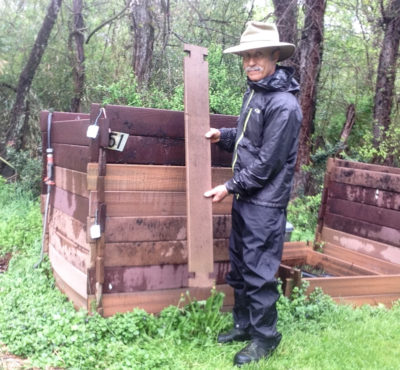
My original “ultimate design” bins were made from wood, which needed replacement every 8 to 10 years. Present bins are made from artificial wood decking, which should hold up forever.
While not a necessity for making compost, a bin does keep everything neat and tidy, keeps scavenging animals and wind-blown weed seeds at bay, and retains heat and moisture for quicker and more thorough composting. As I wrote a few paragraphs earlier, “Any pile of organic materials will eventually become compost.”
Transplant Design
Speaking about good design . . . With so many transplants to water, any method of automatic watering is a godsend. Right now, a couple of hundred of my seedlings are growing in individual, plastic cells sitting on capillary mats. As soil dries out in the cells, it sucks up water from the capillary mat which, in turn, draws water from the reservoir below it. This, the APS system, works very well.
And now an even better design has come down the pike, one made out of terra cotta that, unless dropped, is sure to outlast plastic systems. Cells for a tray of Orta Seed Pots are all housed together in an attached reservoir. One advantage of this design is that cells absorb water throughout their terra cotta walls. Another advantage is that each cell has a drainage hole, so periodic top watering can leach out excess minerals that can build up in pots watered from below.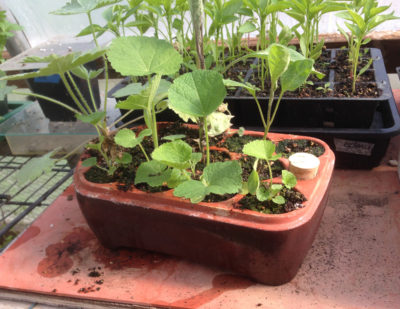
The only downside to Orta Seed Pots is that they are expensive. Then again, they can potentially last forever, and they grow very good plants. The design is so elegant and effective (as borne out by some seedlings that I raised in Orta’s) that I’m going to shamelessly help in their promotion with a link, (www.ortakitchengarden.com/factory-seconds-sale/),to discounted factory seconds, which work perfectly but have cosmetic flaws, or, till the end of May, discounted firsts (www.ortakitchengarden.com), with discount code ORTAMAY).
GRAPE EXPECTATIONS
/5 Comments/in Fruit, Gardening, Pruning, Soil/by Lee ReichHello Vanessa
A few days ago was the perfect day for planting the Vanessa grape vine deposited here by the UPS guy. Not because the weather was warm and sunny or because working outdoors was made all the more pleasant with peach, pear, and plum trees in all their glory, awash in white or pink blossoms. And not because the plums were suffusing the air with a most delectable fragrance.
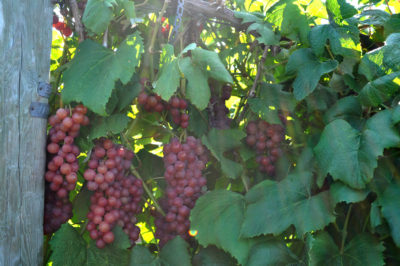
Vanessa grape
The day was perfect for planting because the soil was in such good tilth. With each shovelful, clumps of soil broke apart under their own weight. A far cry from decades ago in my first garden, around this time of year, when digging brought up clods of Wisconsin soil still sticky and wet.
In wet soil, digging drives air out of the soil; under such conditions, roots of trees, shrubs, vines, and seedlings suffer. Better to wait for the soil to dry before planting. But not too long. Soil that is too dry turns rock-hard, too hard to crumble into small pieces to sift amongst roots. All this is moot in sandy soils, which never hold enough water to make them too wet for planting. 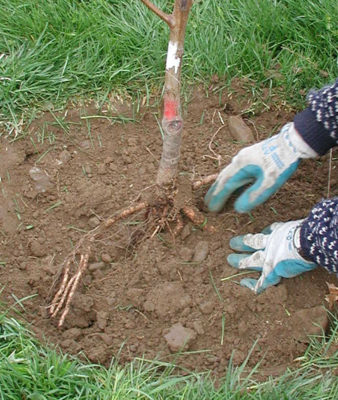
My present ground is a clay loam, which could be poor for planting if too wet. It wasn’t, because, first of all, it hadn’t rained for a few days. Second, warm weather had warmed the soil, the warmth speeding downward movement of excess water. And third, years and years of mulching with leaves, hay, and compost had made the ground rich in organic matter whose goodness had worked its way down through the soil profile with the help of earthworms and other soil organisms, rain, and the action of alternate freezing and thawing. Organic matter, among other benefits, acts as a glue to aggregate soil particles into a crystalline-like structure that helps with holding both air and water.
Training And Pruning Plans
I can bank on Vanessa growing well her first season in the ground. Soon after she arrived, bare-root, I had her roots plumping up with a day-long soak in water. Her planting hole was just deep enough to let her sit at the same depth as in the nursery, and one-and-a-half to twice the spread of the roots across. I clipped back a couple of long, straggly roots.
Holding the stem with one hand, I pushed the soil I had dug out of the hole back in amongst the roots, working it in with my fingertips after initially sifting soil in among the smaller roots by bouncing the plant up and down a little. With the roots nestled into their planting hole, I sprinkled a couple of gallons of water to further settle the soil and get the plant off to a good start.
She arrived with five strong-looking canes jutting up just above where her roots splayed out. Too many, for my purposes. Like her established neighbors, Vanessa will be trained to a “high wire double cordon spur pruned” system, a mouthful that sounds more complicated than it is. Two trunks will rise, unbranched, to about 6 feet in height to the middle wire of a five-wire trellis. One trunk will continue its journey horizontally along the middle wire in one direction; the extension of the other trunk will do likewise in the opposite direction. These two horizontal growths are permanent fixtures, called cordons (same root as the word “cord”). 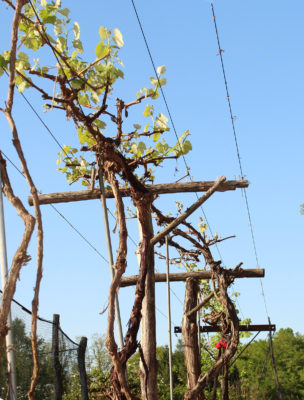
Grapes bear fruits on one-year old stems — these are the so-called “canes,” easily identified by their smooth, reddish brown bark and roughly pencil-thickness. New shoots growing from buds on canes bear bunches of grapes and can drape on the remaining wires on either side of the middle wire.
The following year, the new shoots become one-year-old canes. Without pruning (or with incorrect pruning), fruiting shoots and canes each year move further and further away from the cordon, so I cut each cane back to 2 buds in winter and, after a few years, cut them all the way back, to be replaced by new canes that are always popping out right from the cordon.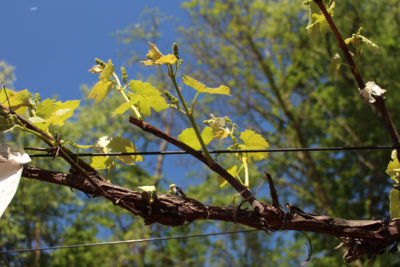
But all this is in Vanessa’s future. This year, all I want from her is two strong trunks.
Don’t Do What I Did
Rain fell, and I didn’t follow my own advice. Because I needed to convert a lumpy old garden area next door to lawn, and because lawngrass establishes best in cool weather, and because I had two helpers coming in a few days to help with ground preparation, I readied the area with a rototiller. I did so even though rain had been falling all day long. Rain fell even while I was tilling.
All in all, it was a horrible experience. Mud everywhere. Wrestling the tiller. Loud engine chugging away. (Now I remember one reason for my book, Weedless Gardening. Weed-less-ness comes, in part, from dispensing with tilling, which awakens buried weed seeds by exposing them to light. And there’s the added benefit of not having to till.)
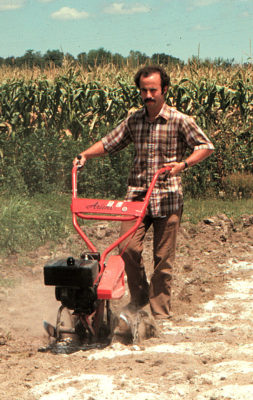
Youthful, foolish Lee, tilling
With good drainage, the job finally got done without excessive destruction of soil structure. And anyway, I was only planting lawngrass.

